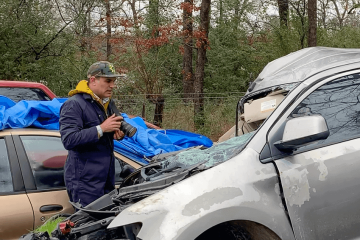Catastrophic Injury Representation in McAllen and Legal Options for Severe Trauma

When a devastating accident alters the course of a person’s life, the path forward is rarely straightforward. Survivors and their families must juggle complex medical decisions, long-term care needs, and financial uncertainty while processing profound emotional changes. In the Rio Grande Valley, access to knowledgeable legal guidance can shape whether a claim covers only immediate bills or truly reflects a lifetime of consequences. The Omar Ochoa Law Firm focuses on building claims that account for the whole picture, from advanced medical care to lost earning power and enduring pain. This article explains how catastrophic injury cases are defined, what proves long-term losses, and why the right experts and strategies matter in McAllen.
Defining Catastrophic Injuries and Their Long-Term Consequences
Catastrophic injuries are not defined solely by their severity at the scene; they are defined by their permanent impact on daily life. Brain trauma, spinal cord damage, severe burns, amputations, and multiple orthopedic fractures can lead to ongoing medical intervention, diminished independence, and changes in family roles. Many survivors face mobility limitations, cognitive challenges, and heightened vulnerability to complications such as infections or chronic pain syndromes. The costs go far beyond hospital bills, encompassing assistive technology, home and vehicle modifications, and attendant care. Because these injuries reshape a person’s future, a thorough legal claim must capture what that new future realistically requires.
What qualifies as catastrophic under Texas law?
In Texas, there is no single statutory checklist for catastrophic harm, but courts and insurers evaluate permanence, degree of functional loss, and the breadth of medical needs. A condition that prevents someone from returning to their occupation, requires lifelong therapy, or causes persistent neurological deficits commonly fits the catastrophic profile. This classification influences case strategy because it justifies robust expert testimony, comprehensive life care planning, and economic modeling. A Catastrophic Injuries Lawyer McAllen can document how impairments restrict activities of daily living and forecast long-term risks such as pressure sores or post-traumatic epilepsy. By connecting medical realities to legal standards of damages, attorneys make the consequences clear to adjusters, mediators, and jurors.
Common Causes of Life-Altering Accidents in Texas
Trauma that changes a life can happen in an instant, but certain patterns appear again and again in South Texas. High-speed collisions on I‑2 and I‑69C, trucking crashes involving underride or jackknife dynamics, and oilfield incidents involving equipment failures frequently produce severe outcomes. Construction falls from height, electrocutions, and trench collapses also drive catastrophic claims, as do defective products that fail under stress and medical negligence that magnifies an initial injury. Each mechanism leaves a signature trail of evidence—event data recorder downloads, safety logs, maintenance histories, and clinical imaging—that a skilled team must preserve quickly. The difference between an ordinary settlement and a life-sustaining recovery often lies in how thoroughly that trail is developed.
High-risk scenarios in the Rio Grande Valley
Regional context matters because traffic density, industrial activity, and cross-border commerce all influence risk. For instance, freight corridors increase exposure to multi-vehicle crashes, while agricultural operations introduce heavy machinery hazards and visibility challenges. Residential fires in older housing stock can lead to deep burn injuries tied to faulty wiring or missing smoke alarms, while rural hospital transfers may delay definitive care and worsen outcomes. A Catastrophic Injuries Lawyer McAllen will tailor investigation plans to these realities, coordinating site inspections, witness canvassing, and expert retention in the first weeks after an accident. By aligning local patterns with forensic analysis, attorneys can pinpoint responsibility and present a compelling, fact-driven narrative.
The Role of Expert Witnesses and Medical Specialists in Litigation
Catastrophic injury cases are won or lost on the strength of credible, understandable explanations of medicine, mechanics, and money. Neurosurgeons, physiatrists, and burn specialists contextualize clinical records, while neuroradiologists interpret imaging to connect symptoms with objective findings. Vocational rehabilitation experts assess transferable skills and why certain impairments prevent re-entry into the workforce, and economists quantify lost earning capacity over decades. Life-care planners outline the *what, why,* and *how much* of future care, from replacement wheelchairs to home health aides. This multidisciplinary bench transforms medical complexity into a roadmap a jury can trust.
Translating complex medicine for juries
Expert testimony must do more than impress; it must meet evidentiary reliability standards and communicate clearly. In Texas, challenges to expert opinions focus on methodology and whether the testimony reliably applies to the facts, which means reports must be detailed, sourced, and testable. Visual aids—3D spinal models, day-in-the-life videos, and timelines of rehabilitation—help bridge the gap between charts and lived experience. The Omar Ochoa Law Firm emphasizes rehearsal and coherence among specialists so each witness builds on the other, avoiding contradictions that insurers exploit. When experts connect mechanism of injury, objective findings, and functional losses in a cohesive arc, decision-makers can see both causation and consequences.
Projecting Lifetime Medical Costs and Future Care Expenses
Long after discharge, the true cost of catastrophic harm emerges through recurring therapies, periodic surgeries, medications, and supportive services. Accurate projections must reflect the expected lifespan, likely complications, and regional costs, not just national averages. A robust plan accounts for mobility aids, home modifications, pressure-relief systems, psychological counseling, and respite care for family caregivers. It also considers replacement cycles for equipment and inflation in healthcare services, anchoring the numbers in widely recognized datasets. Without this depth, a settlement risks covering the first few years while leaving decades unfunded.
Building a credible life care plan
A defensible life care plan integrates treating physician input with independent assessments from rehabilitation specialists, ensuring medical necessity is well documented. Planners should specify quantities, frequencies, and vendor pricing for each category of care, then apply accepted economic methodologies to estimate present value. Defense experts often argue for lower utilization or shorter life expectancy; countering that requires literature support, mortality tables adjusted for injury-specific factors, and clinical rationales. A Catastrophic Injuries Lawyer McAllen works closely with planners and economists to sync assumptions and guard against double-counting or gaps. The result is a clear, evidence-backed blueprint that explains every dollar requested and why it matters to the client’s dignity and independence.
Handling Insurance Disputes in High-Value Injury Claims
Insurers scrutinize catastrophic claims because payout exposure can stretch into millions, especially when multiple defendants or commercial policies are involved. Coverage investigations may examine exclusions, late notice, or whether an at-fault driver was within the course and scope of employment, which affects available limits. Coordinating layers—primary, excess, umbrella—and exploring underinsured motorist benefits requires meticulous policy analysis and a strategy that prevents carriers from passing the buck. Medical liens and subrogation interests can further complicate negotiations, reducing the net recovery if not managed proactively. Strong advocacy aligns timelines, coverage opinions, and evidence into a settlement posture that is hard to ignore.
Tactics that move insurers toward fair settlements
Well-crafted demands do more than present numbers; they frame liability clearly, document damages exhaustively, and set reasonable deadlines. In Texas, time-limited demands that thoroughly disclose evidence and invite inspection can create pressure if a carrier undervalues clear liability and significant harm. Early mediation may test theories and reveal reserve positions, but meaningful movement often follows depositions that show how a witness will play before a jury. The Omar Ochoa Law Firm pairs meticulous documentation with trial readiness—accident reconstruction, treating doctor narratives, and economic models—so negotiation is backed by courtroom credibility. When insurers see that a jury could accept the client’s story and math, settlement discussions become more realistic.
Comparative Fault and Its Effect on Compensation Eligibility
Texas uses proportionate responsibility, which reduces damages by the claimant’s percentage of fault and bars recovery entirely if that share exceeds 50 percent. In catastrophic cases, even a modest allocation to the injured person can wipe out critical funds for long-term care. Defense teams often argue that a plaintiff’s speed, distraction, or safety noncompliance contributed to the outcome, while minimizing institutional or corporate negligence. The analysis becomes especially complex in multi-party events, where fault may be divided among drivers, employers, contractors, or product manufacturers. Addressing these dynamics early can protect eligibility and keep negotiations grounded in a fair apportionment.
Evidence that minimizes fault apportionment
Reducing fault calls for a disciplined investigation: vehicle event data, cell phone forensics, visibility and sightline studies, and compliance with federal or industry safety rules. Expert reconstruction can show how inadequate training, maintenance lapses, or defective design were the dominant causes, displacing blame from the injured party. Credible witness preparation and targeted impeachment of unreliable accounts help ensure the narrative remains consistent and persuasive. A Catastrophic Injuries Lawyer McAllen will also preserve spoliation arguments where evidence disappears and use third-party fault to shift percentages appropriately. By weaving technical proof with a human story of caution and responsibility, attorneys protect both eligibility and the size of the award.
How Skilled Advocacy Secures Justice for Severely Injured Clients
Catastrophic cases demand an approach that is both analytical and deeply human. Strategy starts with preserving evidence and building a team of specialists, then moves through careful valuation of medical and economic losses. Savvy negotiation leverages liability clarity and trial readiness while counseling clients on settlement structures, special needs trusts, and tax-advantaged plans that safeguard benefits. Trial preparation—mock juries, demonstratives, and *day-in-the-life* films—ensures that, if settlement falls short, the story of loss and resilience is ready for the courtroom. The objective is not simply compensation, but durable resources that restore as much independence and dignity as possible.
What to look for in counsel
Experience with high-stakes litigation, deep networks of medical and economic experts, and a record of results in the local courts are essential. Look for transparent communication, willingness to front case costs, and a practice that limits caseload so complex matters receive sustained attention. Local insight into judges, mediators, and defense firms can influence both timing and tactics, especially in cases involving multiple carriers or corporate defendants. A Catastrophic Injuries Lawyer McAllen who prioritizes client goals—stability, access to advanced care, and security for dependents—will tailor strategy accordingly. The Omar Ochoa Law Firm brings this blend of resources and focus to bear, aligning legal firepower with the lived needs of people facing the hardest chapter of their lives.











